Sorry I couldn’t resist the title. Ponds large and small can have duck weed as a problem. A chat with the owner of an aquatic nursery, last weekend, confirmed that I had this in my small pond. Duck weed is a tiny floating weed that in its thousands makes a light green carpet on the surface of the water as you will see in the photo below.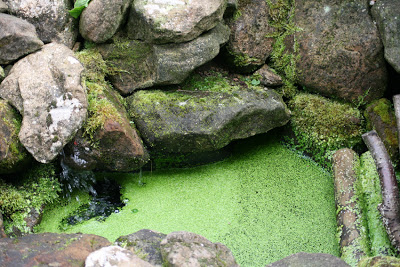
The solution was as I thought too – a small fishing net! So, yesterday I went fishin’ and scooped up most, but not all, of the duck weed as you can see in the photo below. I decided I would come back to it again today to scoop some more out as that would allow it time to settle to the edges once again. A warning here though if you think that sorts it completely– you only need to leave one tiny piece and the plant will once again it will multiply.
So the chances of completely removing this from your pond are really slim. So it is more a case of control – regularly fishin’ to remove it is not really all that time consuming or strenuous in a small pond. The duck weed itself does not do any harm to the water – in fact the aquatic nursery owner told me that actually did some good by taking nitrogen away.
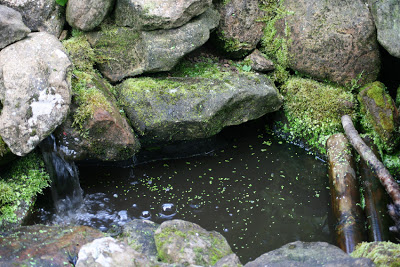
Emptying the pond ‘would that not work?’ I hear you ask. Well, for a while perhaps and so would washing the roots of any new aquatic plants to make sure you don’t add it yourself. However, it can also be brought in on the feet of water fowl, in the case of large ponds, or by garden birds visiting small ponds or water features. That’s where the common name ‘duck weed’ comes from. I have also had this problem in the past, many years ago, and I did try emptying my pond and I can say from experience I did not successfully succeed in removing it completely.
My pond is small although my photos perhaps make it look more like a small water feature. In April 2006 I had a pond liner doubled up but the water levels kept dropping and when I discovered a tear I decided to rebuild it. I then used a moulded plastic kidney shaped pond, with shelves at the sides for placing plants in baskets. I had one in another part of the garden so decided to move it. I took a bit of time and patience to rebuild it but I love working with stone so I didn’t mind.
My plan was to rebuild the area around the pond with hidden caves both under the surface and all along one side. I have always hoped frogs would hop into my pond so got quite a surprise to find a toad when I was emptying it! I don’t know who got the bigger fright! I put the toad in some of the old pond water in a bucket with a lot of rocks in and on top. I had no idea if it would stay there. I must have scooped it up with the water as I don’t remember catching it. I thoroughly enjoyed building my network of caves and the pond shelves were very useful in supporting some of the rocks in the water. I also built caves out of the water in the hope a wren would consider nesting there but I have only seen a field mouse passing in and out these caves so far.
I placed two small pieces of wooden support poles across the width to act as a bridge for the birds to drink from and for the toad and any frogs to get out – I have enjoyed seeing the birds use this. The rocks I used are sandstone – I had them in other parts of the garden. Yes, I know perhaps not an ideal stone in the long term but by that time I will probably revamp the area anyway. What the sandstone in this area does give is beautiful mosses, as you will see in the remaining photos below.
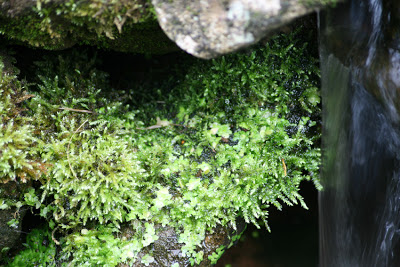
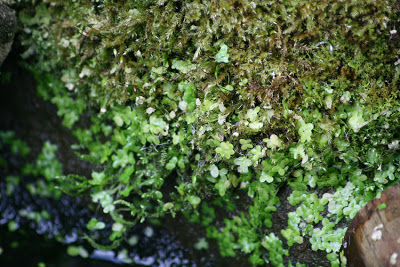
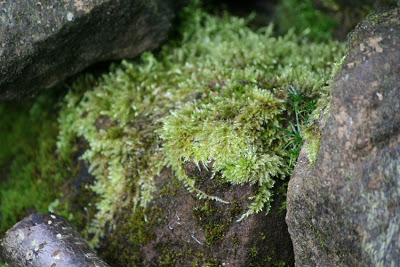
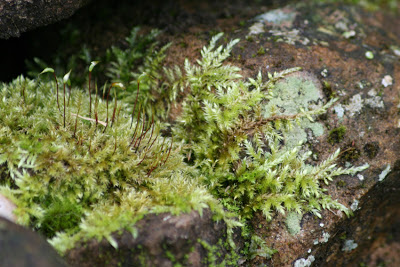
I love these mossy rocks around the pond and only this morning watched a Dunnock bounce around the rocks and take insects from it. This moss was also used by our Camera Nestbox Blue Tit female to build her nest. At the moment I love to see the beautiful natural patterns this moss is making as it grows on the sandstone. However, if you look closely at the photos below you will see the duckweed has clung to the moss too. So it is the duckweed or the moss. The moss wins hands down – now I will just have to live with fishing the duckweed out from time to time.
What about the toad? Well, the pond change was made two years ago and at the time it remained in the bucket until I was able to return it into the pond later that day. I was able to do that as I had enough rain water collected to refill my pond. I also added some of the dirty water from the bucket as that gave the pond back the living organisms that were already living there. In February I cleaned the pond once more, removing dead leaves from the bottom as they were causing the surface to look oily. No sign of the toad then at all.
Last night as I put food out for the hedgehog I looked across at the pond and saw how low the level had dropped as it does when we have dry spells. I filled my watering can a few times, this time direct from outside tape as it was only a top up, and without the rose power washed the logs to remove more of the duck weed. Then once again I got a fright as two legs pushed themselves from the edge beside the logs – our toad also got a power shower! Of course I have no idea if it is the same one or there has been a family of toads in my pond. I am just thrilled that my pond/pool has wildlife using it as it was built especially for it!
The photos above were taken in my garden on September12th 2007.
Shirl: I just love moss rocks and took some pictures of them just this morning! Love the pond!
You did a great job on the pond and I love the mossy rocks.
Fishing out the duck weed – it’s an endless job isn’t it?! Due to the weather this summer the duck weed has grown more and I’ve done less fishing. A major pond clear up is needed here too.
The mossy rocks are lovely and look really natural, what a lovely place for the toads and birds.
Celia
Hi again, Layanne, Robin and Celia – thanks for your comments 🙂
Layanne – I had a feeling I wouldn’t be the only one that loved moss rocks! Thanks, although my pond is more like a rock pool it’s great to look out on throughout the seasons – even when it is iced over 🙂
Robin – thanks! What I like about my pond is knowing that there are so many hidden areas 🙂
Celia – Yes, I had read it was a bad year in the UK for duck weed. Good luck with your pond clear out – post photos it would be good to see what you do. It is the natural look that I enjoy. The branch beside the log bridge didn’t quite go back as it was, not deliberately, and today it has be used as a perch for the birds to land on before jumping down to the waters edge to drink 🙂
Hi Shirl–
What a beautiful, very natural looking pond! We have plans for a super small one ourselves–and I would love it if it looked half as good as yours does! Glad to hear the critters are enjoying it, too.
Hi there, Lisa
Thank-you! I have always thought of it as a small pond but perhaps with all the rocks I have hidden below the surface it should be called a rock pool 🙂 You say you have plans for a super small pond. How small? Scale in photos can be deceiving – I would say mine is super small 🙂
I have just gone outside and measured the surface area of the water in my pond. It measures just under one metre long with the width across the log bridge at only 45cm! I look forward to reading the progress of your pond in the future 🙂
Hi Steve is back again (Lisabee’s neighbor here in beautiful Northern California)….yeah this is pretty strange “chatting” with my neighbor via Scotland..but hey, its a new age huh?
(Hi Shirl..this is for you too!)
Ah, the garden pond…China and I talked about a small pond too, but alas, both of us here in CA have racoons and ‘possums to deal with. (Is there such things in Scotland?)…creatures who lived here long before us and return periodically in the dead of night to eat the ripe grapes from the back deck trellis or “fish” ‘da fish out of your pond for dinner (washing their hands in the process…that’s the racoons in action).
A local potter makes a kit of ceramic rim pieces to fit around a cut wine barrel half and has an option to electrify the rim to fend off the hungry critters. (Denfense against the Dark Arts?)
Also, been wondering for a few years now about those little aphid eaters that work the underside of the sunflowers….does California really have Bushtits or Coaltits? Cute name but?….at one point China thought they might be some kind of tiny warbler. (?)
Are they same thing…just different names across the oceans?
Welcome back, Steve! LOL Yes, definitely new age 🙂
Re garden pond – why don’t you try a rocky pool with gaps too small for the racoon to get in them – just a thought? No we don’t have racoons here and I’m not actually sure what would be their equivlent – perhaps a fox? Generally speaking foxes aren’t welcome in gardens in the UK. It’s cats and the bird ‘heron’ that go fishin’ in UK garden ponds. I don’t think UK Laws would permit electricifation of wildlife – under any circumstances. That doesn’t mean however that culls don’t happen over here – they are just very closely monitored.
Not sure what your aphids are but I would suggest you encourage birds into your garden as particular species have great appetites for aphids! Perhaps Lisa would know? In the UK we try to encourage the natural predator to deal with our plant problems 🙂
China is perhaps close by thinking the Coal Tit is a warbler but my books here refer to the Order: Passeriformes, Family: Paridea and Species: Parius ater. The Bushtit appears to be Psaltriparus minimus and I don’t believe is found outside America. Although I have to say that you are correct – birds can have different names in other countries but not in this case 😉